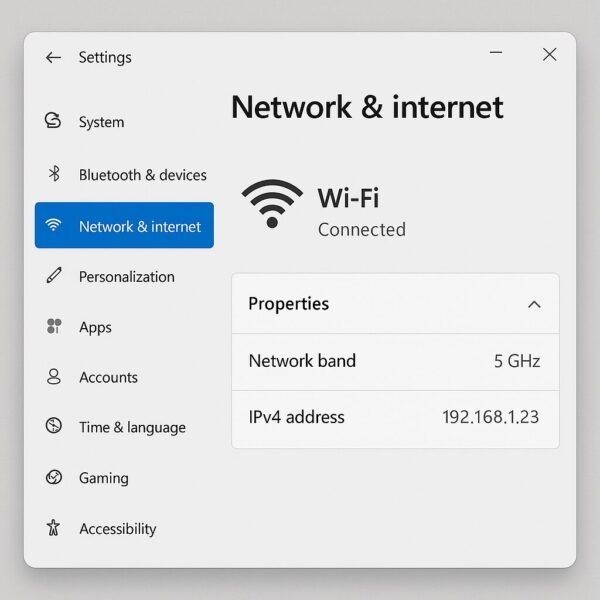
Your IP address is like a mailing address for your PC on a network. You’ll actually have two kinds in everyday use:
- Private (local) IP — used inside your home/office network (often starts with 192.168.*, 10.*, or 172.16–31.*).
- Public (external) IP — seen on the internet by websites and online services (usually assigned by your ISP or VPN).
Below are super‑clear, click‑by‑click ways to find both, plus what each number means and what to do if nothing shows up.
- 1 Quick Answer (Local/Private IP)
- 2 Method 1: Settings (Most Beginner‑Friendly)
- 3 Method 2: Quick Settings on the Taskbar (Great for Wi‑Fi)
- 4 Method 3: Command Prompt (Fast and Works Offline)
- 5 Method 4: PowerShell (Copy‑Paste Friendly)
- 6 Method 5: Classic Control Panel (If You Prefer the Old Way)
- 7 How to Find Your Public(External) IP
- 8 Which Method Should You Use?
- 9 “Nothing Shows Up” or Address Looks Weird? (Fixes)
- 10 Safe‑Use & Privacy Notes
- 11 Summary
Quick Answer (Local/Private IP)
- Press Windows logo key + I to open Settings.
- Open Network & internet.
- Click your current connection:
- Wi‑Fi → click the Wi‑Fi network name (Properties)
- Ethernet → click Ethernet
- Scroll down to IPv4 address. That’s your local/private IP.
- You may also see IPv6 address; that’s the newer internet protocol. It’s fine to have both.
💡 Even faster: Press Windows key, type cmd, press Enter, then run:
[ ipconfig ]Look for your adapter (Wi‑Fi/Ethernet) → IPv4 Address.
What These Numbers Mean (30‑second primer)
- IPv4 vs IPv6: IPv4 looks like 192.168.1.23 (four numbers). IPv6 looks like 2400:abcd:… (long, with colons). Many networks use both.
- Private vs Public: Private IP works only inside your local network (your router translates it to the public IP using NAT). Public IP is what the wider internet “sees.”
- Dynamic vs Static: Most home users get dynamic IPs that can change when devices or routers restart. Businesses sometimes use static IPs that stay fixed.
Hide your public IP and protect your privacy with a fast, reliable VPN.
▶ Get NordVPN Here
Method 1: Settings (Most Beginner‑Friendly)
For Wi‑Fi
- Press Windows + I → Network & internet → Wi‑Fi.
- Click your Wi‑Fi network name (it may say Properties).
- Scroll to Properties (or IP settings).
- Find IPv4 address (and IPv6 address, if shown).
For Ethernet (wired)
- Press Windows + I → Network & internet → Ethernet.
- Scroll to IPv4 address.
Why this works: Windows collects the details the network adapter received from your router (DHCP) and shows them here. IPv4 is what most troubleshooting guides still ask for.
Method 2: Quick Settings on the Taskbar (Great for Wi‑Fi)
- Click the network icon on the right side of the taskbar (next to the clock).
- Click the arrow ▶ next to your Wi‑Fi name.
- Choose Properties (or i / info icon) to open the detailed page.
- Note the IPv4 address.
Why this works: It’s a shortcut to the same Settings page without hunting through menus.
Method 3: Command Prompt (Fast and Works Offline)
- Press Windows key, type cmd, press Enter.
2. Run:
[ ipconfig ]3. Find your active adapter section:
- Wireless LAN adapter Wi‑Fi for Wi‑Fi
- Ethernet adapter Ethernet for wired
Look for IPv4 Address.
Why this works: ipconfig reads the configuration directly from the network stack. It’s reliable even when the Settings app is slow or unavailable.
Method 4: PowerShell (Copy‑Paste Friendly)
- Press Windows key, type powershell, press Enter.
2. For a clean list of your IPv4 address(es):
3. To copy your Wi‑Fi IPv4 to the clipboard:
Why this works: PowerShell cmdlets expose the same data as ipconfig, but they’re easy to filter, format, or automate.
Method 5: Classic Control Panel (If You Prefer the Old Way)
- Press Windows key + R, type:
press Enter.
2. Next to Connections, click your Wi‑Fi or Ethernet link.
3. Click Details…
4. Read IPv4 Address.
Why this works: The legacy network stack UI is still present and shows full adapter details in one dialog.
How to Find Your Public(External) IP
Option A: Use a Search Engine
- Open your browser and search: what is my IP.
The result usually shows your public IPv4/IPv6 at the top.
Option B: Use PowerShell
(Requires internet access.)
Privacy tip: Your public IP can reveal your approximate location to websites. If you’re on a VPN, the public IP will be the VPN’s, not your ISP’s. Disconnect the VPN to see your ISP‑assigned public IP.
Which Method Should You Use?
| Situation | Best Method | Why |
|---|---|---|
| You’re new to Windows | Settings → Network & internet → (Wi‑Fi/Ethernet) | Clean, guided, no commands needed. |
| You want it fast | Command Prompt (ipconfig) | Very quick and works offline. |
| You need to copy or automate | PowerShell | Script‑friendly output; easy to filter and reuse. |
| You prefer the classic UI | Control Panel → Network and Sharing Center | Familiar dialog with full adapter details. |
| You need the internet‑visible IP | Search “what is my IP” (or use a public‑IP checker) | Shows your public IPv4/IPv6 clearly. |
“Nothing Shows Up” or Address Looks Weird? (Fixes)
Symptom: IPv4 shows as 169.254.x.x
- That’s an APIPA address → your PC didn’t get an address from the router.
Fix:
- Restart your router and PC.
2. Reconnect to Wi‑Fi (or replug Ethernet).
3. Try renewing the address:
ipconfig /renew
4. Check that the network adapter is Enabled (Settings → Network & internet → Advanced network settings → More network adapter options).
Symptom: No IPv4, only IPv6
- Many ISPs and routers support IPv6 now. That’s okay. If an app insists on IPv4, ensure your router’s DHCPv4 is on, or try ipconfig /renew.
Symptom: ipconfig shows no adapters
- The adapter/driver may be disabled or missing. Device Manager → Network adapters → check for warnings, enable/update the driver.
Symptom: On Wi‑Fi, it flips between connected and disconnected
- Move closer to the router, forget & re‑add the network, or try a different 2.4/5GHz band. Consider updating your Wi‑Fi driver from the PC maker’s support site.
Safe‑Use & Privacy Notes
- Don’t share your public IP in screenshots or forums unless support staff asks for it.
- Private IPs (like 192.168.1.23) are safe to share for troubleshooting — they are not reachable from the internet.
- Using a VPN changes your public IP for privacy; your private IP inside Windows usually stays the same.
Handy Commands You Can Copy
ipconfig /all
:: Release and renew IPv4 (DHCP)
ipconfig /release
ipconfig /renew
:: Clear DNS cache (helpful for name‑resolution hiccups)
ipconfig /flushdns
Get-NetIPAddress -AddressFamily IPv4 | Where-Object {$_.IPAddress -notlike “169.254.*”} | Select-Object IPAddress, InterfaceAlias
# Show your public IP (requires internet)
(Invoke-WebRequest -Uri “https://api.ipify.org”).Content
FAQ
Q. Which one should I tell tech support — IPv4 or IPv6?
A. If they don’t specify, give IPv4; it’s the most commonly requested.
Q. Why does my friend have a totally different number?
A. Public IPs differ by household or VPN. Private IPs differ by device within the same home.
Q. My IP keeps changing. Is that bad?
A. Not at all. Dynamic addresses are normal for home connections. It only matters for things like port‑forwarding or remote access.
Q. I see 10.* / 192.168.* — is that wrong?
A. That’s normal for a private IP behind a router. The internet sees your public IP instead.
Summary
- Settings → Network & internet → (Wi‑Fi/Ethernet) shows your private IPv4 quickly.
- ipconfig is the fastest technical method and works offline.
- To see what the internet sees, check your public IP with a search engine or PowerShell.
- If you get 169.254.*, renew your address or restart the router.
In short, knowing how to find your IP address in Windows 11 isn’t just a tech skill — it’s a simple way to take control of your network troubleshooting and privacy. Whether you’re setting up a new device, fixing a connection issue, or sharing details with tech support, these methods ensure you can quickly get the right information every time. The more familiar you are with these tools, the easier it becomes to navigate and resolve network-related problems with confidence.
✔️You might also find these helpful:
▶︎Scanner Not Detected or Resolution Setting Not Applied in Windows
▶︎How to Connect to Wi-Fi in Windows 11 (Beginner’s Step-by-Step Guide)
▶︎How to Use Public Wi-Fi Safely Without a VPN
▶︎Wi-Fi Connected but No Internet? Fix It with These 7 Simple Steps
▶︎9 Easy Ways to Fix “Wi-Fi Not Connecting” on Windows
💡 Looking for more tips? Check out our full list of Windows Help Guides.


